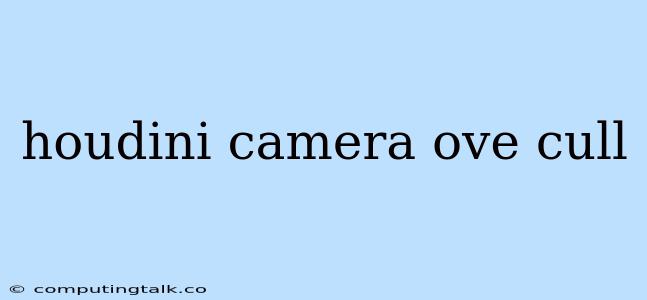Houdini is a powerful 3D animation and visual effects software that offers a wide range of tools for creating stunning visuals. One important aspect of achieving realistic and compelling shots in Houdini is camera control. When working with complex scenes and large numbers of objects, it is crucial to ensure that only the desired elements are visible within the camera's view. This is where the "cull" functionality comes into play.
What is Camera Cull?
Camera cull, in the context of Houdini, refers to the process of selectively excluding objects from rendering based on their position relative to the camera. Essentially, objects that are outside the camera's view are "culled" or hidden from the final render. This process serves several important purposes:
- Improved performance: By excluding objects that are not visible, the rendering process becomes significantly faster, as the software doesn't need to process unnecessary geometry.
- Reduced memory consumption: Cull can reduce the amount of data that Houdini needs to load and process, optimizing memory usage.
- Cleaner results: By eliminating unnecessary elements, the final render appears cleaner and more focused, minimizing distractions and improving the overall visual quality.
How to Implement Camera Cull in Houdini
Houdini provides several methods for implementing camera cull, each with its own advantages and use cases.
1. The "Cull" Node
The "Cull" node is a powerful and versatile tool for managing camera cull in Houdini. It allows you to define various cull parameters, including:
- Cull Mode: You can choose from different cull modes, such as "Camera" (culled by the camera's view frustum) or "Plane" (culled by a user-defined plane).
- Cull Object: You can specify which objects to cull, using a variety of options like name, group, or selection.
- Cull Type: You can choose whether to cull objects completely or simply hide them from the viewport.
The "Cull" node is a flexible option that offers precise control over the culling process.
2. "Object Merge" Node
The "Object Merge" node can be used to cull objects based on their attributes. You can set up a condition that checks if an object is within the camera's view and only merge the objects that satisfy the condition. This method can be useful for managing complex scene hierarchies and applying cull selectively based on specific object properties.
3. Houdini's "Camera" Node
Houdini's "Camera" node has a built-in "cull" option that can be enabled to cull objects that are outside the camera's view. This is a simple and straightforward method for applying camera cull to all objects in the scene.
Tips for Effective Camera Cull
- Understand your scene: Analyze the composition of your scene to determine which objects are likely to be outside the camera's view. This will help you make informed decisions about which objects to cull.
- Use culling strategically: Don't over-cull, as this can lead to performance issues and unexpected visual artifacts.
- Test and refine: After implementing cull, test your scene and refine your cull parameters to ensure that you are achieving the desired results.
Common Pitfalls and Solutions
- Unexpected culling: Make sure that your cull parameters are correctly configured and that your objects are properly grouped or named.
- Performance issues: If you are experiencing performance issues, try using a more efficient cull method or optimizing your scene geometry.
- Visual artifacts: Be aware that camera cull can sometimes lead to visual artifacts, especially near the edge of the camera's view.
Conclusion
Camera cull is an essential technique for optimizing performance and achieving cleaner renders in Houdini. By selectively excluding objects that are not visible, you can significantly improve rendering times, reduce memory consumption, and enhance the overall visual quality of your shots. By mastering camera cull techniques, you can unlock the full potential of Houdini and create stunning visual effects with ease.
